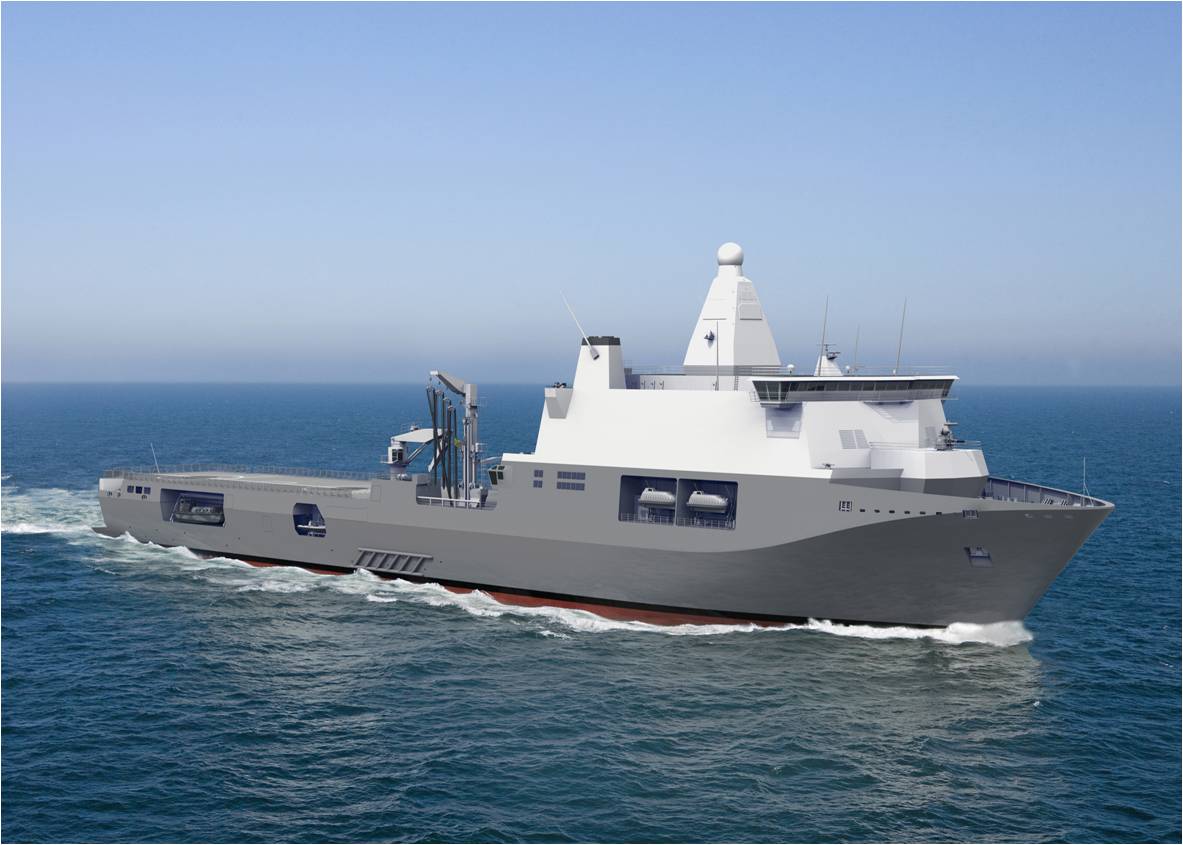On the plus side, it is getting a proven design, as three of these ships are serving in the German navy. However, it is also firmly closing the book on a much more ambitious, multi-role ship that it once intended to build. That ship would resemble the Dutch Karel Doorman, which will not only supply ships at sea but transport troops and equipment for amphibious landings and serve as a flagship, too. The decision will leave the RCN without the capability to do any of these things except the basic replenishment at sea.
 |
| Canadian Joint Support Ship Proposal |
 |
| Karel Doorman |
Instead, the single-minded solution we have chosen is quite similar in size and displacement to the ships it is replacing. It also has the advantages of less maintenance, a smaller crew, and a double hull (which is a legal requirement these days). Its 44-bed hospital is also an improvement.
 |
| HMCS Protecteur |
| FGS Berlin |
On the other hand, it actually carries less in the way of supplies than the ships it is replacing. Have a look at some figures.
Protecteur
|
Berlin
|
Karel
Doorman
|
|
Displacement
(tonnes)
|
24,700
|
20,240
|
28,246
|
Length
(m)
|
172
|
173
|
204.7
|
Beam
(m)
|
23
|
24
|
30.4
|
Speed
(km/h)
|
37
|
37
|
33
|
Fuel and water (m^3)
|
14,232 (ship fuel); 390 (aviation fuel)
|
10,032 (in total)
|
8,000 (ship fuel); 1,000 (aviation fuel)
|
Solid Cargo, including ammunition (tonnes)
|
1048 (dry cargo); 1250 (ammunition)
|
550
|
|
Complement
|
365
(including air detachment)
|
139
(+94)
|
150
(+150)
|
Aircraft
Carried
|
3
medium helicopters
|
2
medium helicopters
|
2
Chinook helicopters or 6 medium
|
Landing
Craft
|
2
Landing Craft Vehicle Personel
|
||
2
Rigid Hull Inflatable Boats
|
In addition, we should compare our $2.6 or $4.1 billion ships to the new British replenishment oilers. They are getting four 37,000-ton oilers built for only £452 million ($712.8 million Canadian). They have achieved this phenomenal value by designing the ships at home but shipping the plans to the Daewoo Shipyard in South Korea to build.
 |
| A British MARS Tanker (Tide Class) fuelling a Type 45 Destroyer |
I wonder what it would have cost us to say to Daewoo, "Two more of the same, please."
Also for comparison, the Dutch are paying $480 million US for the Karel Doorman. Two at that price would have fit our budget, but some of the building would have to be done overseas. For example, the Dutch are having the hull built in Romania.
Our Defence Minister, Peter MacKay, has explained that we spend "a premium" to build ships in Canada. That is fair enough, but I am staggered by the size of the premium that we have to pay.
I do hope that the Canadian economy benefits from the government's spending on this project and the others in its shipbuilding strategy. I will enjoy seeing the ships being constructed on the North Vancouver waterfront, too. However, there is more at stake than the the economy and even my personal likes: the RCN and "the Canadian Forces as a whole" are putting their future into the hands of Canadian industry. People's lives, as well as livelihoods, depend on how well they respond.
--------------------------------------------------
Update 12 October 2013
There's a CBC report stating that the replenishment ships are a higher priority than the replacement for Canada's big Coast Guard ice breaker, the Louis St. Laurent. That means
- We have a date for the start of construction of the replenishment ships: construction will start "in late 2016 with a target of having them in service by 2019-20, almost two years later than the last estimate contained in last spring's federal budget."
- As for the Louis St-Laurent (the Coast Guard ice breaker), it will have to "remain in service until 2021-22, but it will require as much as $55 million in refits and upgrades to keep going over 10 years." Fortunately, the ship is in good shape at the moment. The year in which her replacement will be ready was not included in the article.
- The Canadian Navy will be without replenishment ships for at least 18 months because the old ships must retire before the new ships are ready.
Opposition New Democrats were quick on Friday to paint the decision as another procurement failure.
"Let's be clear: these critical shipbuilding projects are facing delays because of the Conservative decision to cancel the Joint Support Ship procurement process in 2008," NDP defence critic Jack Harris said in a statement.
"That restart means that the Canadian navy will now face a two-year gap in resupply capacity, during which time Canada will have to rely on allies for essential resupply capabilities. The Canadian navy's capacity to conduct independent marine operations during this period will be greatly reduced."
A recent report by the parliamentary budget office suggested that had the Conservatives stuck with the original program, the navy would already have its ships, and likely for less money than what they'll eventually pay.
This comment has been removed by a blog administrator.
ReplyDelete